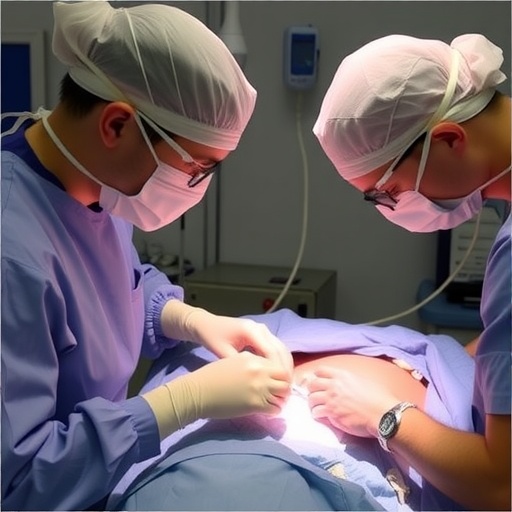A recent study presented in the Annals of Biomedical Engineering has revealed significant advancements in the methodologies used for peripheral vessel cannulation, a critical procedure in medical practices. This study, led by Liddelow and colleagues, compares two innovative techniques: Point Localization and Pathway Visualization. The importance of this research cannot be overstated, as efficient cannulation can substantially impact patient outcomes, particularly in emergency and surgical settings where time is of the essence.
Cannulation, the process of inserting a tube into a vessel to allow for the administration of drugs or fluids, has long been a challenging task for medical professionals. Traditional methods often result in complications or require multiple attempts, causing discomfort to patients and delays in treatment. The study aims not only to improve technique efficacy but also to minimize patient trauma and reduce the duration required for the procedure, which can be life-saving in critical situations.
Point Localization, one of the methodologies explored, relies on advanced imaging techniques to help medical professionals accurately identify target veins. These techniques enhance the visibility of vascular structures, guiding clinicians more effectively during the cannulation process. By reducing the guesswork involved, Point Localization promises to streamline the procedure and increase the success rate, particularly in patients with difficult venous access.
On the other hand, Pathway Visualization takes a more interactive approach. This technique combines augmented reality with traditional imaging methods, enabling clinicians to visualize the optimal pathway for cannulation in real-time. The immersive experience provided by Pathway Visualization allows clinicians to engage with the vascular landscape as if they were operating in a three-dimensional space. This innovative approach could redefine how vascular access is approached in medical training and practice.
The exploratory nature of this study underscores the potential for technology to enhance medical procedures. As vascular access can often be arduous, especially in critically ill patients or those with anatomical challenges, the advent of these methods signifies a vital step towards optimized patient care. Improving the efficacy of cannulation not only benefits healthcare practitioners in their protocols but also leads to more favorable experiences for patients.
In the study conducted by Liddelow and his team, a comparative analysis was performed to identify which method yielded better outcomes in terms of both performance speed and accuracy. Utilizing a comprehensive set of metrics, the team was able to provide a deeper understanding of the nuances associated with each technique. The results are expected to serve as a foundational reference for further studies aimed at developing next-generation tools for cannulation assistance.
In addition to performance metrics, participant feedback was gathered to gauge perceptions surrounding the two approaches. Clinicians reported varying levels of confidence when utilizing the different techniques, further highlighting the psychological factors that come into play during such critical healthcare tasks. Establishing a more robust training framework based on these findings could potentially enhance practitioner confidence and, in turn, improve patient care.
The implications of these findings extend beyond the operating room. If successfully implemented, these advanced techniques could inspire changes in medical education, leading to the incorporation of technology-driven methods in training programs. This adoption may equip future healthcare providers with cutting-edge skills, ensuring they are well-prepared to meet the challenges presented by complex clinical situations.
Moreover, as hospitals begin to incorporate technology into everyday practices, cost-effectiveness becomes a pertinent topic. While the initial investment in imaging technology may be significant, the reduction in complications and improved patient satisfaction could offset long-term expenses. This economic perspective becomes essential as healthcare providers evaluate how best to allocate resources while still enhancing care delivery.
Another significant aspect of this research is its focus on patient-centric outcomes. Enhancements in cannulation techniques have the potential to drastically reduce patient discomfort, which is critical, particularly in pediatric or anxious populations. For many patients, the fear associated with medical procedures can exacerbate their already stressful situations. Streamlining processes and improving success rates diminishes anxiety and builds trust in healthcare systems.
Looking toward the future, advancements in machine learning and artificial intelligence could further complement these methodologies. As algorithms become smarter, they may assist healthcare providers by analyzing patient data to offer predictions about vein quality or accessibility, thus enhancing decision-making in real-time during procedures. The integration of artificial intelligence in medical practices represents an exciting horizon for the field of biomedicine.
In summation, the study examining the efficacy of Point Localization versus Pathway Visualization establishes a critical milestone in the ongoing quest for enhancing peripheral vessel cannulation techniques. With the potential for improved clinical outcomes and an emphasis on patient-centered care, this research not only enriches the medical community but also signifies a transformative shift towards more technologically-integrated healthcare solutions. As the medical field continues to evolve, studies such as this pave the way for future innovations aimed at redefining patient care.
As this research continues to gain traction, the hope remains that broader adoption of these techniques will spur further developments in complementary technologies, creating a robust ecosystem of care that prioritizes efficiency, accuracy, and above all, the well-being of patients. The insights garnered from Liddelow and his team’s work have opened the door to a new era in medical procedures, one where technology and healthcare professionals work hand in hand for better outcomes.
The journey of refining peripheral vessel cannulation is ongoing, but with each advancement, we move closer to a future where patient care is consistently improved through innovative practices and robust methodologies. The medical field stands on the precipice of an exciting transformation that promises to revolutionize how we approach one of its fundamental procedures.
Subject of Research: Peripheral vessel cannulation techniques
Article Title: Comparing the Efficacy of Peripheral Vessel Cannulation Assistance Utilizing Point Localization and Pathway Visualization
Article References:
Liddelow, M.D., Hansen, E.L., Ho, P.H. et al. Comparing the Efficacy of Peripheral Vessel Cannulation Assistance Utilizing Point Localization and Pathway Visualization. Ann Biomed Eng (2025). https://doi.org/10.1007/s10439-025-03899-5
Image Credits: AI Generated
DOI: https://doi.org/10.1007/s10439-025-03899-5
Keywords: Peripheral vessel cannulation, Point Localization, Pathway Visualization, medical technology, patient care, procedural efficacy.




